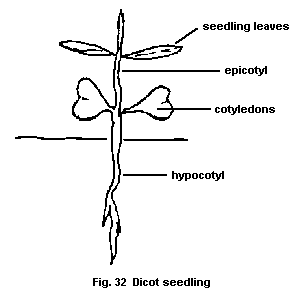|
[Front Page] [Features] [Departments] [SGAP Home Page] [Subscribe]

A Good Read
.....what's current in print and on disk?
| Reviews in this issue cover "Growing Rainforest - Restoration and Regeneration" by Robert Kooyman, "A Beginner's Botany" by Barry Kemp and "Native Plants of the Sydney District' by Alan Fairley and Philip Moore. |
 |

 Growing Rainforest - Rainforest Restoration and Regeneration
Robert Kooyman
Published by State Forests of New South Wales, 1996
$AUS25
Reviewed by Sue Walston.
This book is clearly designed for people who want to be practically involved in the regeneration of rainforest ecosystems. Reading through it you get a strong sense that Kooyman is really trying to help the reader understand how rainforests work so that anyone attempting to undertake rainforest restoration or regeneration work has a good chance of working with nature rather than against it. This is evident in his systematic treatment of information.
He begins in Chapter 1 (Rainforest types) with an outline of rainforest types and related climatic factors and provides good references for those who would like to study these in more detail. The book then starts to gather momentum.
Chapter 2 (Rainforest regeneration and succession) gives a thorough description of the natural processes involved in the regeneration of the rainforest canopy after damage by natural or man-made causes. This gives a good idea of how things work and how best to reproduce these
processes if you want to do more for a site than just fence it. Kooyman emphasises the problems that can occur during the regeneration process that can prevent the forest progressing through the various successional stages to its final form and gives useful examples of problems and the reasons for them.
Chapter 3 (Ex-rainforest sites) builds on this by examining a range of typical problems found in rainforest remnants, including weed problems associated with gaps in the canopy or a high ratio of edge to established forest area, lack of seed sources particularly of late succession species, and various other issues all of which can help in analysing your own site and designing a suitable revegetation plan to suit local conditions.
Chapter 4 (Rainforest plantings) outlines three planting models designed to minimise the effects of problems discussed in the preceding chapter.
Chapter 5 (Planting guidelines and hints) provides a comprehensive list of actions required for the planning and implementation of rainforest regeneration programs applicable to various rainforest types. It's practical and is well worth following, particularly for large scale works, and provides information on soil preparation, planting techniques, fertilising and mulching, windbreaks, edge planting and record keeping.
Chapter 6 (Trial comparisons) gives a critical assessment of the six trial plantings on which the three models described in Chapter 3 are based. Useful transect diagrams are also provided with species and successional information included.
Chapter 7 (Species groups and successional stages) consists of a list of rainforest species (nearly 200) set out according to their successional stages and growth characteristics. Previously this information has been hard to find and lots of people will welcome it. It will greatly help in the development of planting plans and facilitate forward ordering of plant supplies.
Chapter 8 (Wildlife and rainforest) lists some of the nectar and larval food plants for butterflies although the chapter title does suggest a wider cross-section of animal life. There is also a useful bibliography comprising 72 references on all aspects of planning and managing rainforest projects including articles that address wildlife and ecology issues that are integral to a healthy rainforest.
I hope this work will spawn other practical research of a similar nature for rainforests outside of the humid sub-tropics, although the principles developed in the text can certainly be applied to different climatic environments. Kooyman's book really does fill a huge gap in the practical rainforest literature and I am confident it will result in more of the right trees in the right places for which people and wildlife will consciously, or unconsciously reap benefits.
Reprinted from the October 1996 issue of the newsletter of SGAP's Rainforest Study Group.

 A Beginner's Botany
Barry Kemp
Published by the Coffs Harbour Group of the Australian Plants Society
30 pages, soft cover, $AUS6.50 (within Australia), $AUS7.50 (overseas), including postage.
Reviewed by Brian Walters
Q. Do you have trouble telling your perianth from your receptacle? Well...don't we all?
Q. Do you always get your pedicle tangled up with your peduncle?
Q. Are you unsure whether you should pronounce the bottlebrush genus as CalliSTEmon (with the emphasis on the third syllable) or as CallISTemon (with the emphasis on the second syllable) or indeed as CallisteMON (if you just want to be perverse)?
Q. Do you understand why perfectly good botanical names suddenly get changed to something else? Why is Sturt's Desert Pea now known as Swainsona formosa when Clianthus formosus seemed satisfactory for so long?
A. You need a copy of "A Beginner's Botany" for answers to all of the above and more.
This is unashamedly a low budget production. There is no colour - just clear text and informative (simple) line drawings. With so much of the modern world being obsessed with packaging as a disguise for mediocre content, it's refreshing to see a production where the aim is to inform. As a result, the publication's price has been kept down to ridiculous levels and it is very accessible.
  The publication is logically arranged and guides the reader gently through the following topics:
The publication is logically arranged and guides the reader gently through the following topics:
- Plant classification and nomenclature; A guide to the binomial system of naming plants, the problems and derivation of common names, why latin is used by botanists, the concepts of "family", "genus", "species", "variety", "subspecies", "type specimen" and "synonyms".
- Application of the correct "rules"; Reasons for name changes, pronunciation.
- Different kinds of plants; Spore-bearing (fork ferns, clubmosses, horsetails, ferns), seed-bearing plants (gymnosperms and angiosperms), monocotyledons and dicotyledons.
- Flowers; How flowers are arranged, floral structures and forms.
- Seeds; How they are carried, components, dormancy and germination.
- Fruits; Types (simple, aggregate, multiple and accessory), fleshy, dry, dehiscent and indehiscent fruits
- Vegetative structures; Roots, stems, lignotubers, leaves, bracts, bracteoles, stipules and other leaf modifications such as phyllodes and "needles".
- Plant identification; The use of plant "keys" and a simple key to the genus Blandfordia.
|
All of that (and more) in just 30 pages!!!
A comprehensive glossary and a list of references complete the package.
No matter how long you have been interested in plants and botany, there is always a term cropping up that you haven't seen before. This booklet is by no means a comprehensive guide to all things botanical but, if you don't find a term explained here, you probably don't need to know what it means.....

 Native Plants of the Sydney District
Alan Fairley and Philip Moore
Published by Kangaroo Press (in association with the Society for Growing Australian Plants)
432 pages, over 1450 colour photographs, hard cover, $AUS80
Reviewed by SGAP Victoria Newsletter Team
The area covered in this book lies between Nowra in the south, Newcastle in the north and includes the Blue Mountains to the west. From over 2000 species of plants in the area, 1447 are dealt with by colour photographs, brief descriptions and notes on habitat, distribution and flowering times. Although mostly small, the photographs are generally clear, showing either plant form or moderately
close up detail (occasionally both).
The text is briefly introduced with descriptions of the environments of the area, a geological outline and brief illustration notes on the major vegetation types. The body of the text covers most types of vegetation including ferns (74 species), a few gymnosperms, but mainly angiosperms including over 100 species of grasses and rushes.
The level of scientific jargon is not high, and terms used are defined in a glossary. There is a guide to the plant families and a full index, all of which make the book user friendly.
Obviously aimed at the Sydney market, the book is too large for a field guide, but the format makes it a pleasure to browse or use as a not too technical reference to the vegetation of the area.
Reprinted from the September 1996 issue of the newsletter of the Victorian Region of SGAP.
 [Front Page] [Features] [Departments] [SGAP Home Page] [Subscribe]
[Front Page] [Features] [Departments] [SGAP Home Page] [Subscribe]
Australian Plants online - September 1997
The Society for Growing Australian Plants
|






